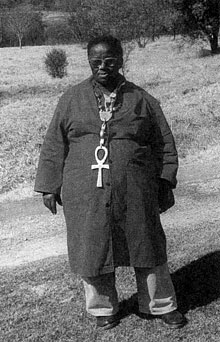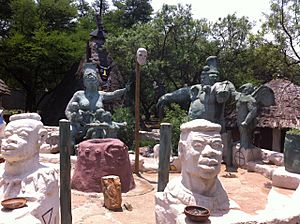Vusamazulu Credo Mutwa facts for kids
Quick facts for kids
Vusamazulu Credo Mutwa
|
|
|---|---|

Credo Mutwa in Soweto, South Africa (1997)
|
|
| Born | 21 July 1921 Natal, Union of South Africa
|
| Died | 25 March 2020 (aged 98) |
| Nationality | South African |
| Other names | Credo Mutwa |
| Occupation | Author |
| Known for | Sangoma, Story-Telling, Sculptor |
Vusamazulu Credo Mutwa (born July 21, 1921 – died March 25, 2020) was a famous Zulu sangoma. A sangoma is a traditional healer and spiritual guide in South Africa. He was known for his books about African myths, Zulu stories, and his own experiences.
His last big project was a graphic novel series. It was called the Tree of Life Trilogy. This series was based on his well-known book, Indaba my Children. In 2018, he received an USIBA award. The South African Department of Arts and Culture gave him this award. It honored his work in sharing traditional African wisdom.
Credo was also a sanusi. This is an older term for a type of Zulu diviner or sangoma. It is not used much today. Credo lived with his wife Virginia in Kuruman. They ran a special clinic there.
Contents
Early Life and Calling
Credo Mutwa's father was a builder and a Christian. His mother was a young Zulu girl. Because of their different backgrounds, his parents had to separate. Credo was born before they were married. This caused a big stir in their village. His mother was asked to leave her home. Later, one of his aunts took him in.
He was then raised by his father's brother. They moved to the South Coast of Natal. This area is now called KwaZulu-Natal. Credo did not go to school until he was 14 years old. In 1935, his father found a building job. The whole family moved to the Transvaal province where he was working.
Credo became very sick. Modern medicine could not help him. So, his uncle took him back to KwaZulu-Natal. His grandfather, whom his father did not like, helped him get better. His grandfather was a traditional healer. This experience made Credo question many things. He wondered if Africans truly had no knowledge before Europeans arrived.
His grandfather taught him that his illness was a special sign. It meant he was meant to become a sangoma, a healer. He went through thwasa. This is the training and initiation process for sangomas. His grandfather and his mother's sister, Mynah, helped him. Mynah was also a young sangoma.
Kwa-Khaya Lendaba Cultural Village
In 1974, Credo Mutwa got land in the Oppenheimer gardens in Soweto. He wanted to build an African cultural village. His goal was to protect African heritage and his teachings. He built traditional homes. These homes showed building styles from all over Africa. He also made sculptures of people and mythical figures. These sculptures brought African stories and beliefs to life.
At first, local people were unsure about the village. Many were Christians and were suspicious of traditional ways. Credo believed that the big problems in Johannesburg, like the Soweto uprising, made Africans forget their old traditions. He thought that keeping white and black cultures separate might help preserve black traditions.
In 1976, students partly burned down the village. They thought Credo was promoting tribalism. Parts of the village were burned again in the mid-1980s. This happened during a protest against the local city council.
After his son was killed and his village was burned again, Credo moved. He left Soweto and built another cultural village. This one was in Lotlamoreng, Mahikeng. Here, he oversaw the building of small villages. Each one showed the traditional cultures of different South African tribes.
Today, the Kwa-Khaya Lendaba cultural village in Soweto is being fixed up. It is still open to visitors for free. Guides are available to show people around.
Prophetic Sculptures
Many sculptures at Kwa-Khaya Lendaba were unique to Credo's vision. Some people believe that a number of his sculptures were able to predict the future. One famous example is his sculptures of King Khandakhulu. This king was said to have 200 wives. These sculptures were made in 1979. This was three years before scientists found the HIV virus. People say these sculptures predicted the coming of HIV/AIDS to South Africa.
Other predictions linked to his sculptures include the destruction of the World Trade Centers. This happened during the September 11 attacks. People also say he predicted Chris Hani's assassination. He is also said to have predicted the removal of president Thabo Mbeki.
Views on Traditional Medicine
Credo Mutwa strongly supported using traditional African medicine. He believed it could help treat illnesses like HIV/AIDS, cancer, and tuberculosis. In 1999, he started the Vulinda Trust. This trust aimed to protect traditional knowledge. It also promoted the use of these traditional medicines.
His main research focused on a South African plant. It is called unwele in Zulu. Its scientific name is Sutherlandia frutescens. This plant is traditionally used as a health tonic. Studies have also shown it might help fight cancer. Research into how Sutherlandia frutescens can help with HIV/AIDS is still happening.
See also
 In Spanish: Credo Mutwa para niños
In Spanish: Credo Mutwa para niños


